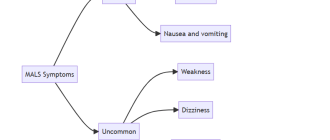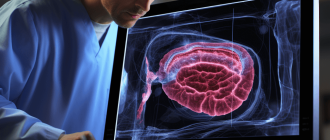 Common Signs and Symptoms of Abnormalities in the Celiac Artery
Common Signs and Symptoms of Abnormalities in the Celiac Artery
The celiac artery is a major blood vessel that supplies oxygenated blood to the abdominal organs, including the liver, stomach, spleen, and pancreas. When there is an abnormality or blockage in the celiac artery, it can lead to various symptoms and complications.
One of the most common symptoms of celiac artery abnormalities is abdominal pain. This pain is typically located in the upper abdomen and may be described as a dull ache or a sharp, stabbing pain. The pain may worsen after eating or with physical activity. In some cases, the pain may radiate to the back or chest.
Another symptom of celiac artery abnormalities is weight loss. The reduced blood flow to the abdominal organs can affect their function and lead to a decrease in appetite and weight loss. This weight loss may be accompanied by other digestive symptoms, such as diarrhea, bloating, and nausea.
In severe cases, celiac artery abnormalities can lead to organ failure. If the blood flow to the liver is significantly compromised, it can result in liver dysfunction and jaundice. Similarly, reduced blood flow to the pancreas can cause pancreatitis, a condition characterized by inflammation of the pancreas. These complications require immediate medical attention.
If you experience any of these symptoms, it is important to consult a healthcare professional for a proper diagnosis and treatment. Celiac artery abnormalities can be diagnosed through imaging tests, such as ultrasound or CT scan, and may require surgical intervention to restore normal blood flow.
What are the symptoms of celiac artery aneurysm?
Celiac artery aneurysm is a rare condition that occurs when there is a bulge or ballooning in the wall of the celiac artery, which is a major blood vessel that supplies blood to the stomach, liver, and other organs in the upper abdomen. In many cases, celiac artery aneurysms are asymptomatic, meaning they do not cause any noticeable symptoms. However, in some cases, they can cause symptoms that may vary depending on the size and location of the aneurysm.
If a celiac artery aneurysm becomes large or starts to press on nearby structures, it can cause symptoms such as:
- Abdominal pain: A celiac artery aneurysm can cause persistent or intermittent abdominal pain, which may be mild or severe. The pain may be localized to the upper abdomen, and it may worsen after eating or with physical activity.
- Nausea and vomiting: Some people with a celiac artery aneurysm may experience nausea and vomiting, particularly if the aneurysm is causing a blockage or obstruction in the blood flow.
- Weight loss: Unexplained weight loss may occur if the celiac artery aneurysm is affecting the blood supply to the digestive organs, leading to reduced appetite and malnutrition.
- Feeling of fullness: If the aneurysm is pressing on the stomach or other nearby organs, it can cause a feeling of fullness or early satiety, even after eating small amounts of food.
- Back pain: In some cases, a celiac artery aneurysm can cause back pain, particularly if it is pressing on the surrounding nerves or structures.
If you experience any of these symptoms, it is important to consult a healthcare professional for a proper diagnosis. Celiac artery aneurysms can be detected through imaging tests such as ultrasound, CT scan, or angiography. Treatment options for celiac artery aneurysms may include watchful waiting, medication, or surgical intervention, depending on the size and risk of rupture.
Celiac artery aneurysms may cause diffuse abdominal pain
Celiac artery aneurysms refer to the abnormal dilation of the celiac artery, a major blood vessel responsible for supplying blood to the abdominal organs. This condition is relatively rare, but when present, it can lead to various symptoms, including diffuse abdominal pain.
The term “diffuse abdominal pain” refers to a type of pain that is not localized to a specific area but rather spreads throughout the abdomen. It is often described as a dull, cramp-like discomfort that may be accompanied by a feeling of fullness or bloating.
In the case of celiac artery aneurysms, the pain may be caused by several factors. The enlarged artery can compress nearby structures, such as the stomach or intestines, leading to irritation and discomfort. Additionally, the aneurysm may disrupt blood flow to the abdominal organs, resulting in ischemia (lack of oxygen) and subsequent pain.
It is important to note that diffuse abdominal pain can have various causes, and celiac artery aneurysms are just one possible explanation. Other conditions, such as gastrointestinal disorders or inflammatory diseases, can also present with similar symptoms. Therefore, a thorough medical evaluation is necessary to determine the underlying cause of the pain.
If a celiac artery aneurysm is suspected, diagnostic tests, such as ultrasound or computed tomography angiography, may be performed to visualize the blood vessels and confirm the presence of an aneurysm. Treatment options for celiac artery aneurysms can vary depending on the size and location of the aneurysm, but may include surgical repair or endovascular techniques.
Celiac artery aneurysms can cause diffuse abdominal pain due to the compression of nearby structures and disruption of blood flow to the abdominal organs. If experiencing persistent or severe abdominal pain, it is essential to seek medical attention for proper diagnosis and treatment.
The pain can be intermittent or constant
One of the main symptoms of celiac artery abnormalities is abdominal pain. This pain can vary in intensity and duration. It can be intermittent, meaning it comes and goes, or it can be constant, lasting for extended periods of time.
When the pain is intermittent, it may be triggered by certain activities or after eating. Patients may experience episodes of severe pain followed by periods of relief. This can make it difficult to pinpoint the exact cause of the pain.
On the other hand, constant abdominal pain can be more persistent and severe. It can greatly affect a person’s quality of life and daily activities. This type of pain may indicate a more serious underlying condition, such as a blockage or narrowing of the celiac artery.
It is important to note that the pain associated with celiac artery abnormalities may not always be localized to the abdomen. Some patients may experience referred pain, meaning the pain is felt in other areas of the body, such as the back or shoulders.
If you are experiencing any type of abdominal pain, especially if it is severe or persistent, it is important to seek medical attention. A healthcare professional can help diagnose the underlying cause of the pain and recommend appropriate treatment options.
Some aneurysms are asymptomatic and found incidentally
While some abdominal aortic aneurysms can cause noticeable symptoms, such as abdominal or back pain, many are asymptomatic and are discovered incidentally during routine medical examinations or imaging tests. These silent aneurysms may go unnoticed for years, as they do not typically cause any discomfort or pain.
It is important to note that even though an aneurysm may be asymptomatic, it still poses a potential risk. If left untreated, it can continue to grow and eventually rupture, leading to life-threatening complications. Therefore, it is crucial for individuals at risk or with a family history of aneurysms to undergo regular screenings to detect and monitor any potential abnormalities.
When an aneurysm is discovered incidentally, further evaluation is usually recommended to determine its size, location, and overall condition. This may involve additional imaging tests, such as computed tomography angiography (CTA) or magnetic resonance angiography (MRA), to assess the extent of the abnormality and guide treatment decisions.
In some cases, the discovery of an asymptomatic aneurysm may prompt immediate intervention, especially if it is large or rapidly growing. Treatment options for abdominal aortic aneurysms include open surgical repair or endovascular repair, depending on the specific characteristics and location of the aneurysm.
Overall, it is important for individuals to be aware that some aneurysms can be asymptomatic and found incidentally. Regular screenings and medical examinations can help detect and manage these abnormalities, reducing the risk of complications and ensuring timely treatment if necessary.
What happens if the celiac artery is blocked?
If the celiac artery, also known as the celiac trunk, becomes blocked, it can lead to a condition called celiac artery occlusion. This occurs when there is a significant reduction or complete blockage of blood flow through the artery that supplies oxygen-rich blood to the stomach, liver, spleen, and other vital organs in the upper abdomen.
When the celiac artery is blocked, it can cause a range of symptoms and complications. Some of the common signs and symptoms include:
- Abdominal pain: The most common symptom of celiac artery blockage is severe abdominal pain. This pain may be constant or intermittent and can be felt in the upper abdomen.
- Nausea and vomiting: Blockage of the celiac artery can lead to gastrointestinal symptoms such as nausea and vomiting.
- Weight loss: Decreased blood flow to the digestive organs can result in weight loss, as the body is unable to properly absorb nutrients from food.
- Loss of appetite: Celiac artery occlusion can cause a loss of appetite and a feeling of fullness even after eating small amounts of food.
- Diarrhea: In some cases, celiac artery blockage can lead to chronic diarrhea, as the intestines may not be able to function properly due to reduced blood supply.
- Jaundice: If the liver is affected by the decreased blood flow, it can lead to a yellowing of the skin and eyes, known as jaundice.
If left untreated, celiac artery blockage can result in severe complications, such as organ damage or failure. It is important to seek medical attention if you experience any of these symptoms or suspect a blockage in the celiac artery.
Treatment options for celiac artery blockage may include medications to manage symptoms, lifestyle changes to improve blood flow, or surgical intervention to restore blood flow to the affected organs. The specific treatment approach will depend on the individual case and the severity of the blockage.
A blocked celiac artery can have significant consequences on the functioning of vital organs in the upper abdomen. Recognizing the symptoms and seeking prompt medical attention is crucial to prevent further complications and ensure appropriate treatment.
Blockage of the celiac artery reduces blood flow to abdominal organs
The celiac artery plays a crucial role in supplying oxygen-rich blood to various abdominal organs, including the liver, stomach, and spleen. When this artery becomes blocked or narrowed due to celiac artery abnormalities, it can significantly reduce blood flow to these organs, leading to various symptoms and complications.
When the blood flow to the liver is compromised, it can result in liver dysfunction and may manifest as jaundice, abdominal pain, and abnormal liver function test results. These symptoms can range from mild to severe, depending on the degree of blockage and the duration of reduced blood flow.
Inadequate blood supply to the stomach can cause symptoms such as abdominal pain, bloating, nausea, and vomiting. Additionally, reduced blood flow to the spleen can lead to splenic infarction, which is characterized by severe abdominal pain, fever, and an enlarged spleen. If left untreated, splenic infarction can cause life-threatening complications.
Other abdominal organs, such as the pancreas and small intestine, may also be affected by reduced blood flow due to celiac artery blockage. This can result in pancreatitis, digestive issues, and malabsorption of nutrients, leading to weight loss and nutritional deficiencies.
It is important to recognize the symptoms of celiac artery abnormalities and seek medical attention promptly. Diagnosis usually involves imaging tests, such as angiography or computed tomography angiography, to visualize the celiac artery and identify any blockages or abnormalities. Treatment options may include medication to manage symptoms, surgical interventions to remove blockages or restore blood flow, or minimally invasive procedures such as angioplasty or stenting.
If you experience any of the aforementioned symptoms or suspect celiac artery abnormalities, consult with a healthcare professional for proper evaluation and management.
This can lead to post-meal abdominal pain and weight loss
One of the symptoms of celiac artery abnormalities is post-meal abdominal pain. When the celiac artery is not functioning properly, it can lead to a reduced blood supply to the stomach and intestines. This can cause discomfort and pain in the abdomen, particularly after eating a meal. The pain may be dull or sharp and can vary in intensity.
In addition to abdominal pain, celiac artery abnormalities can also result in weight loss. When the blood supply to the gastrointestinal tract is compromised, it can interfere with the absorption of nutrients from food. As a result, individuals may experience unintentional weight loss, even if their appetite remains unchanged.
If you are experiencing post-meal abdominal pain and unexplained weight loss, it is important to consult a healthcare professional. They can evaluate your symptoms, perform diagnostic tests, and provide appropriate treatment options.
Severe stenosis may cause an audible abdominal bruit
Severe stenosis of the celiac artery, which is the narrowing of the artery, can lead to the development of an audible abdominal bruit. An abdominal bruit is an abnormal sound that can be heard with a stethoscope when listening to the abdomen.
The bruit is caused by turbulent blood flow through the narrowed artery. When the artery is significantly narrowed, blood flow becomes disrupted, leading to a turbulent flow. This turbulent flow produces a whooshing or blowing sound that can be heard by a healthcare professional during a physical examination.
The presence of an audible abdominal bruit can indicate significant stenosis of the celiac artery and may be an indication of underlying vascular disease. It is important for individuals experiencing symptoms such as abdominal pain, weight loss, or digestive issues to seek medical evaluation to determine the cause of their symptoms and rule out any potential celiac artery abnormalities.
Diagnostic imaging tests, such as ultrasound or angiography, may be performed to confirm the presence of severe stenosis and assess the extent of the arterial narrowing. Treatment options for severe stenosis may include medication, lifestyle changes, or surgical intervention, depending on the severity and underlying cause of the abnormality.
Abnormal hardening of the walls of an artery or arteries
Abnormal hardening of the walls of an artery or arteries, also known as arterial calcification or arteriosclerosis, is a condition that occurs when calcium deposits build up in the walls of the arteries. This can lead to the narrowing and hardening of the arteries, which can restrict blood flow to the organs and tissues.
Arterial calcification can occur in any artery in the body, including the celiac artery. The celiac artery is a major branch of the abdominal aorta that supplies blood to the stomach, liver, and spleen. When the walls of the celiac artery become hardened, it can disrupt the normal blood flow to these organs, leading to a variety of symptoms.
Common symptoms of abnormal hardening of the celiac artery walls include:
- Abdominal pain: This can range from mild discomfort to severe pain, and may be felt in the upper abdomen.
- Nausea and vomiting: These symptoms can occur as a result of the disrupted blood flow to the stomach.
- Weight loss: The reduced blood flow to the digestive organs can lead to a decreased appetite and unintentional weight loss.
- Malnutrition: The restricted blood flow can also impair the absorption of nutrients, leading to malnutrition.
- Fatigue: Reduced blood flow can result in decreased oxygen and nutrient delivery to the body’s tissues, leading to fatigue and weakness.
- Other symptoms: Depending on the specific organs affected, other symptoms may include jaundice (yellowing of the skin and eyes), enlarged liver or spleen, and changes in bowel movements.
If you experience any of these symptoms, it is important to consult a healthcare professional for a proper diagnosis and appropriate treatment. Abnormal hardening of the walls of the celiac artery can be diagnosed through imaging tests such as ultrasound, CT scan, or angiography.
Treatment options for abnormal hardening of the celiac artery walls may include lifestyle changes such as adopting a healthy diet, regular exercise, and quitting smoking. Medications to control blood pressure and cholesterol levels may also be prescribed. In severe cases, surgical intervention may be necessary to restore blood flow to the affected organs.
Early detection and treatment of abnormal hardening of the celiac artery walls can help prevent complications and improve the overall prognosis. It is important to be aware of the symptoms and seek medical attention if you suspect you may be experiencing any issues with your celiac artery.
What abdominal symptoms may indicate celiac artery issues?
The celiac artery is an important blood vessel that supplies blood to the abdominal organs. When there are abnormalities or issues with the celiac artery, it can lead to various symptoms in the abdomen. These symptoms may include:
| Symptoms | Description |
|---|---|
| Abdominal pain | Sharp, cramping, or dull pain in the abdomen that may worsen after eating. |
| Abdominal bloating | A feeling of fullness or tightness in the abdomen, often accompanied by excessive gas. |
| Weight loss | Unexplained and unintentional weight loss, which may be due to malabsorption of nutrients. |
| Diarrhea | Frequent loose or watery stools that may be accompanied by urgency or increased frequency of bowel movements. |
| Nausea and vomiting | Feeling of queasiness or an urge to vomit, which may be triggered by eating. |
| Loss of appetite | Reduced desire to eat or a lack of interest in food. |
If you experience any of these symptoms, it is important to consult a healthcare professional for further evaluation and diagnosis. Celiac artery abnormalities can be treated effectively with appropriate medical intervention.
Unexplained abdominal pain, especially after eating, can signal celiac artery disorders
One of the main symptoms of celiac artery abnormalities is unexplained abdominal pain, particularly after eating. This pain can be mild or severe and may persist for hours or even days. It is important to note that this pain is not associated with any specific food or meal, and it does not improve with over-the-counter pain medications.
Individuals with celiac artery disorders may also experience other symptoms such as nausea, vomiting, and bloating. These symptoms can be debilitating and significantly impact daily activities and overall quality of life.
If you are experiencing unexplained abdominal pain, it is essential to seek medical attention. A healthcare professional can perform a thorough evaluation, including medical history, physical examination, and diagnostic tests, to determine the underlying cause of your symptoms.
Early diagnosis and treatment are crucial in managing celiac artery disorders. Depending on the specific abnormality, treatment options may include medications to relieve symptoms, lifestyle modifications, or surgical intervention.
Unexplained abdominal pain, especially after eating, can be a sign of celiac artery disorders. If you are experiencing these symptoms, it is important to consult with a healthcare professional for proper evaluation and treatment.
Weight loss and abdominal bruits are also warning signs
Weight loss and abdominal bruits can also be warning signs of celiac artery abnormalities. These symptoms may indicate a more advanced stage of the condition or the presence of complications.
Unexplained weight loss is often a red flag for underlying medical conditions. In the case of celiac artery abnormalities, weight loss can occur due to decreased appetite, malabsorption of nutrients, and increased metabolism. If you have been losing weight without trying or experiencing a significant decrease in appetite, it is important to consult a healthcare professional for further evaluation.
Abdominal bruits are abnormal sounds that can be heard with a stethoscope. They are caused by turbulent blood flow in the celiac artery due to narrowed or blocked blood vessels. Abdominal bruits are usually detected during a physical examination and may indicate the presence of celiac artery stenosis or occlusion. If you experience abdominal bruits or any unusual sounds in your abdomen, it is crucial to seek medical attention promptly.
It is worth noting that weight loss and abdominal bruits are not exclusive to celiac artery abnormalities and can be associated with various other medical conditions. Therefore, a thorough medical evaluation is necessary to determine the underlying cause of these symptoms.
| Common Symptoms of Celiac Artery Abnormalities | Additional Warning Signs |
|---|---|
| Abdominal pain after eating | Weight loss |
| Nausea and vomiting | Abdominal bruits |
| Diarrhea or constipation | – |
| Bloating and gas | – |
Pain may be diffuse or localized depending on the specific pathology
When it comes to celiac artery abnormalities, pain can vary depending on the underlying condition. In some cases, the pain may be diffuse, meaning it is spread out and not specifically localized to one area. This can make it difficult to pinpoint the exact source of the pain.
On the other hand, pain can also be localized, meaning it is concentrated in a specific area. This can occur when there is a blockage or narrowing of the celiac artery, leading to reduced blood flow to a particular organ or tissue.
It’s important to note that the specific pathology of the celiac artery abnormality will determine whether the pain is diffuse or localized. For example, if there is an aneurysm present, the pain may be diffuse as the enlarged artery affects multiple areas. However, if there is a clot or stenosis in a specific branch of the celiac artery, the pain may be localized to the corresponding organ or tissue.
In addition to pain, other symptoms may also be present depending on the specific pathology. These can include nausea, vomiting, weight loss, diarrhea, and abdominal distension. If you are experiencing any of these symptoms, it is important to consult with a healthcare professional for an accurate diagnosis and appropriate treatment.
How can celiac artery stenosis present clinically?
Celiac artery stenosis refers to the narrowing of the celiac artery, which can lead to a decrease in blood flow to the organs supplied by this artery. The clinical presentation of celiac artery stenosis can vary depending on the severity of the stenosis and the affected organs.
Some common clinical manifestations of celiac artery stenosis include:
- Abdominal pain: Patients with celiac artery stenosis may experience chronic abdominal pain, typically located in the upper abdomen.
- Nausea and vomiting: Reduced blood flow to the stomach can cause symptoms of nausea and vomiting.
- Weight loss: Celiac artery stenosis can lead to malnutrition and weight loss due to impaired blood supply to the small intestine, resulting in malabsorption of nutrients.
- Diarrhea: Chronic diarrhea may occur as a result of malabsorption caused by celiac artery stenosis.
- Abdominal bruits: A vascular bruit, which is an abnormal sound caused by turbulent blood flow, may be heard upon auscultation of the abdomen.
- Hypertension: In some cases, celiac artery stenosis can result in high blood pressure due to the release of renin from the affected kidney.
It is important to note that the clinical presentation of celiac artery stenosis can overlap with other gastrointestinal disorders, making it essential to perform appropriate diagnostic tests to confirm the diagnosis.
Celiac artery stenosis may cause chronic abdominal pain
Celiac artery stenosis refers to the narrowing or blockage of the celiac artery, a major blood vessel that supplies oxygenated blood to the abdominal organs. This condition can lead to chronic abdominal pain, which may be the primary symptom experienced by individuals with celiac artery abnormalities.
The celiac artery is responsible for delivering blood to various organs in the abdomen, including the liver, stomach, and spleen. When the artery becomes narrowed or blocked due to stenosis, blood flow to these organs is compromised. This can result in inadequate oxygen and nutrient supply, leading to chronic abdominal pain.
The pain caused by celiac artery stenosis is typically dull and persistent. It may be located in the upper abdomen and can vary in intensity. Some individuals may experience intermittent pain, while others may have constant discomfort.
In addition to chronic abdominal pain, celiac artery stenosis can also cause other symptoms such as nausea, vomiting, and weight loss. These symptoms may be more pronounced after meals, as digestion increases blood flow demand to the affected organs.
If you experience chronic abdominal pain or have other symptoms suggestive of celiac artery abnormalities, it is important to seek medical attention. A healthcare professional can evaluate your symptoms, perform diagnostic tests, and recommend appropriate treatment options.
| Common Symptoms of Celiac Artery Stenosis |
|---|
| Chronic abdominal pain |
| Nausea |
| Vomiting |
| Weight loss |
Postprandial pain, weight loss, and abdominal bruits can indicate stenosis
One of the symptoms that may indicate the presence of celiac artery abnormalities is postprandial pain. This refers to abdominal pain that occurs after eating a meal. The pain can range from mild discomfort to severe cramping and can last for several hours.
Weight loss is another symptom that can be associated with celiac artery stenosis. When the artery is narrowed or blocked, it can lead to a decrease in blood flow to the intestines, which can result in malabsorption and weight loss. This weight loss may be unintentional and can occur even when a person is consuming a normal amount of food.
In some cases, celiac artery stenosis can cause abdominal bruits. Abdominal bruits are abnormal sounds that can be heard with a stethoscope placed over the abdomen. These sounds are caused by turbulent blood flow through the narrowed or blocked artery. Abdominal bruits are not always present and may only be detected during a physical examination.
It is important to note that these symptoms are not exclusive to celiac artery abnormalities and can be present in other conditions as well. Therefore, if you are experiencing any of these symptoms, it is important to consult a healthcare professional for a proper diagnosis and treatment.
| Symptoms | Description |
|---|---|
| Postprandial pain | Abdominal pain that occurs after eating a meal. |
| Weight loss | Unintentional weight loss due to malabsorption. |
| Abdominal bruits | Abnormal sounds heard over the abdomen caused by turbulent blood flow. |
Severe stenosis can result in foregut ischemia
When the celiac artery experiences severe stenosis, it can lead to a condition known as foregut ischemia. Stenosis refers to the narrowing of the artery, which restricts blood flow to the organs supplied by it.
The celiac artery is responsible for supplying oxygenated blood to the stomach, liver, spleen, and parts of the esophagus and duodenum. When stenosis occurs in this artery, it can significantly reduce the blood supply to these organs, leading to foregut ischemia.
Foregut ischemia can cause a range of symptoms, including severe abdominal pain, weight loss, nausea, vomiting, and bloating. The affected individuals may experience difficulty digesting food, leading to malnutrition and fatigue.
If left untreated, severe stenosis and foregut ischemia can result in serious complications such as gastric ulcers, gastrointestinal bleeding, and even organ failure. Therefore, it is essential for individuals experiencing symptoms of celiac artery abnormalities to seek medical attention promptly for proper diagnosis and treatment.
What pain patterns are associated with celiac artery aneurysms?
Pain patterns associated with celiac artery aneurysms can vary depending on the location and size of the aneurysm. Common symptoms include:
- Severe abdominal pain: This is the most common symptom of celiac artery aneurysms. The pain may be constant or intermittent and can radiate to the back or chest.
- Epigastric pain: Aneurysms located near the celiac artery can cause pain in the upper abdomen, specifically in the epigastric region.
- Back pain: If an aneurysm is pressing against the nerves in the spine, it can cause back pain that may radiate down the legs.
- Flank pain: Aneurysms located near the renal arteries can cause pain in the sides of the abdomen, known as flank pain.
- Abdominal tenderness: In some cases, palpation of the abdomen may reveal tenderness or a pulsating mass.
- Nausea and vomiting: Celiac artery aneurysms can disrupt blood flow to the digestive organs, leading to symptoms like nausea and vomiting.
- Weight loss: If the aneurysm is causing significant damage to the celiac artery, it can lead to weight loss and malnutrition.
If you experience any of these symptoms, it is important to seek medical attention as soon as possible. Celiac artery aneurysms can be life-threatening if left untreated, so early diagnosis and intervention are crucial for a successful outcome.
Celiac artery aneurysms can cause intermittent or constant abdominal pain
Celiac artery aneurysms are a rare but potentially serious condition that can lead to various symptoms. One of the most common symptoms is intermittent or constant abdominal pain.
This pain is often described as a dull ache or a sense of pressure in the abdomen. It may come and go, or it may be constant and persistent. The location of the pain can vary, but it is commonly felt in the upper abdomen, near the stomach.
In some cases, the pain may worsen after eating, particularly after a large meal. This is because the celiac artery, which supplies blood to the stomach, liver, and other organs in the abdomen, may become compressed or obstructed by the aneurysm.
In addition to abdominal pain, celiac artery aneurysms can also cause other symptoms such as nausea, vomiting, weight loss, and a feeling of fullness after eating only a small amount of food.
If you experience any of these symptoms, it is important to seek medical attention. Celiac artery aneurysms can be diagnosed through imaging tests such as CT scans or angiography. Treatment options may include medication to manage pain and prevent complications, or surgical repair of the aneurysm.
It is worth noting that celiac artery aneurysms are rare and usually occur in people with certain risk factors, such as atherosclerosis or connective tissue disorders. However, it is important to be aware of the symptoms and seek medical attention if you experience any abdominal pain or other concerning symptoms.
The pain may be generalized or localized to the upper abdomen
The symptoms of celiac artery abnormalities can vary depending on the specific condition. However, one common symptom is abdominal pain. This pain may be either generalized, meaning it is felt throughout the entire abdomen, or it may be localized to the upper abdomen.
Generalized abdominal pain refers to a dull or achy discomfort that is felt in multiple areas of the abdomen. It may be difficult to pinpoint the exact location of the pain, as it can radiate or spread to different parts of the abdomen.
On the other hand, localized abdominal pain is more specific and is felt in a particular area of the upper abdomen. This area is typically located near the celiac artery, which is the main blood vessel that supplies blood to the stomach, liver, and other abdominal organs.
The pain may be described as a cramping or stabbing sensation, and it may worsen after eating or during physical activity. Some individuals may also experience other symptoms along with the abdominal pain, such as nausea, vomiting, bloating, or changes in bowel movements.
If you are experiencing abdominal pain, it is important to consult a healthcare professional for an accurate diagnosis. Celiac artery abnormalities can be serious conditions that require medical intervention, so prompt evaluation and treatment are essential.
| Symptoms | Description |
|---|---|
| Generalized abdominal pain | Dull or achy discomfort felt throughout the entire abdomen |
| Localized abdominal pain | Specific pain felt in the upper abdomen near the celiac artery |
| Nausea | Feeling of queasiness or the urge to vomit |
| Vomiting | Forceful expulsion of stomach contents through the mouth |
| Bloating | Feeling of fullness or tightness in the abdomen |
| Changes in bowel movements | Alterations in the frequency or consistency of stool |
Sudden, severe pain could indicate a ruptured aneurysm
If you experience sudden, intense pain in your abdomen, chest, or back, it could be a sign of a ruptured aneurysm in the celiac artery. A ruptured aneurysm occurs when the wall of the artery weakens and bursts, causing internal bleeding. This is a life-threatening condition that requires immediate medical attention.
Other symptoms that may accompany a ruptured aneurysm include dizziness, lightheadedness, rapid heartbeat, and low blood pressure. In some cases, you may also notice a pulsating mass in your abdomen.
If you suspect that you or someone else may have a ruptured aneurysm, it is crucial to call emergency services right away. Prompt diagnosis and treatment are essential to prevent further complications and potentially save a life.
Are celiac artery aneurysms always symptomatic initially?
Celiac artery aneurysms are abnormal enlargements of the celiac artery, which is the major blood vessel that supplies blood to the abdominal organs. While some celiac artery aneurysms may cause symptoms right from the beginning, others may not show any symptoms initially.
The presence or absence of symptoms in celiac artery aneurysms can vary depending on various factors, such as the size and location of the aneurysm. In some cases, small aneurysms may not cause any noticeable symptoms initially, especially if they are not pressing on surrounding structures or impeding blood flow significantly.
However, as the aneurysm grows larger, it can start causing symptoms. These symptoms may include:
- Abdominal pain or discomfort
- Feeling of fullness or bloating
- Nausea or vomiting
- Weight loss
- Loss of appetite
- Diarrhea
- Jaundice (yellowing of the skin and eyes)
In some cases, celiac artery aneurysms can also lead to complications, such as rupture or thrombosis (formation of blood clots). These complications can cause severe abdominal pain, internal bleeding, and even life-threatening conditions.
It is important to note that the presence or absence of symptoms does not necessarily indicate the severity or progression of a celiac artery aneurysm. Some aneurysms may remain asymptomatic for a long time, while others may become symptomatic suddenly due to complications.
If you suspect that you may have a celiac artery aneurysm or are experiencing any of the symptoms mentioned above, it is important to seek medical attention promptly. Early detection and treatment can help prevent complications and ensure the best possible outcome.
No, small celiac artery aneurysms often don’t cause symptoms initially
It is important to note that not all celiac artery abnormalities will cause symptoms. In the case of small celiac artery aneurysms, they often do not cause any symptoms initially.
An aneurysm is a bulge or enlargement in the wall of an artery. When it occurs in the celiac artery, which supplies blood to the stomach, liver, and spleen, it can be a cause for concern. However, small aneurysms are generally considered to be less likely to cause symptoms or complications.
Many small celiac artery aneurysms are discovered incidentally during medical imaging tests for other conditions. They may not be causing any symptoms or problems at the time of discovery. In such cases, close monitoring by a healthcare professional is usually recommended to detect any changes in size or potential symptoms.
While small celiac artery aneurysms may not cause symptoms initially, it is important to be aware of potential warning signs as the aneurysm grows or if complications arise. These symptoms may include:
- Abdominal pain: Dull or sharp pain in the upper abdomen that may radiate to the back
- Nausea and vomiting: Especially after eating
- Weight loss: Unintentional weight loss despite normal or increased appetite
- Feeling of fullness: Even after eating small amounts
- Blood in the stool: May appear as bright red or tarry stools
- Jaundice: Yellowing of the skin and eyes
If any of these symptoms occur, it is important to seek medical attention promptly. Small celiac artery aneurysms may remain stable and not cause any problems, but it is crucial to monitor their growth and manage any potential complications to ensure the best possible outcome.
Up to 30% of celiac aneurysms are found incidentally through imaging
In some cases, celiac artery abnormalities, such as aneurysms, may not present any noticeable symptoms. It is estimated that up to 30% of celiac aneurysms are found incidentally through imaging, typically during routine medical examinations or tests for other conditions.
Imaging techniques like ultrasound, computed tomography (CT), or magnetic resonance imaging (MRI) can provide detailed images of the celiac artery and surrounding structures, allowing for the detection of abnormalities. These imaging studies may be performed if a healthcare professional suspects a celiac artery abnormality based on the patient’s medical history, physical examination, or the presence of risk factors.
When celiac artery aneurysms are found incidentally, it is important to evaluate their size, location, and potential risk of rupture. Small aneurysms may not require immediate treatment and can be monitored regularly to assess any changes. However, larger aneurysms or those at risk of rupture may require surgical intervention to prevent complications.
It is worth noting that celiac artery aneurysms are relatively rare compared to aneurysms in other arteries. Nevertheless, early detection through incidental imaging can be crucial in preventing potentially life-threatening complications associated with celiac artery abnormalities.
Larger or rapidly expanding aneurysms are more likely to be symptomatic
In cases of celiac artery abnormalities, larger or rapidly expanding aneurysms are more likely to produce symptoms. Aneurysms are abnormal bulges in blood vessels that can occur in various parts of the body, including the celiac artery. When these aneurysms reach a certain size or expand quickly, they can put pressure on surrounding structures and cause symptoms.
Common symptoms of larger or rapidly expanding celiac artery aneurysms may include:
- Abdominal pain: Patients may experience persistent or intermittent pain in the upper abdomen, often radiating to the back.
- Nausea and vomiting: The pressure exerted by the aneurysm on the surrounding organs can lead to gastrointestinal symptoms such as nausea and vomiting.
- Weight loss: Unexplained weight loss may occur due to reduced appetite or difficulty in eating caused by the aneurysm’s effects on the digestive system.
- Feeling of fullness: Patients may experience early satiety or a feeling of fullness even after eating small amounts of food.
- Blood in the stool: In some cases, larger or rapidly expanding celiac artery aneurysms can cause gastrointestinal bleeding, resulting in the presence of blood in the stool.
- Pulsatile mass: A pulsating mass may be felt in the upper abdomen, indicating the presence of an aneurysm.
- Other symptoms: Depending on the location and size of the aneurysm, patients may also experience back pain, jaundice, or other symptoms related to compression of nearby structures.
It is important to note that not all celiac artery aneurysms cause symptoms, especially smaller or stable ones. However, when an aneurysm grows larger or rapidly expands, it can lead to various symptoms that require medical attention. Early diagnosis and treatment are crucial to prevent complications and improve outcomes for individuals with celiac artery abnormalities.
FAQ:
What are the symptoms of celiac artery abnormalities?
The symptoms of celiac artery abnormalities can vary depending on the specific condition. Common symptoms include abdominal pain, nausea, vomiting, weight loss, diarrhea, and decreased appetite.
How are celiac artery abnormalities diagnosed?
Celiac artery abnormalities can be diagnosed through various imaging tests, such as ultrasound, CT scan, or angiography. Blood tests may also be performed to check for elevated levels of certain enzymes and antibodies.
What are the treatment options for celiac artery abnormalities?
The treatment options for celiac artery abnormalities depend on the specific condition and its severity. In some cases, lifestyle changes, such as a gluten-free diet, may be sufficient. In more severe cases, surgery may be necessary to repair or bypass the affected artery.
Are celiac artery abnormalities hereditary?
There is no clear evidence to suggest that celiac artery abnormalities are hereditary. However, certain genetic factors may increase the risk of developing these conditions.
Can celiac artery abnormalities be prevented?
It is not possible to prevent all cases of celiac artery abnormalities, as some may be caused by congenital defects or other factors beyond control. However, maintaining a healthy lifestyle, including a balanced diet and regular exercise, can help reduce the risk of developing these conditions.
What are the symptoms of celiac artery abnormalities?
The symptoms of celiac artery abnormalities can vary depending on the specific condition, but common symptoms include abdominal pain, weight loss, nausea, vomiting, diarrhea, and malnutrition.






